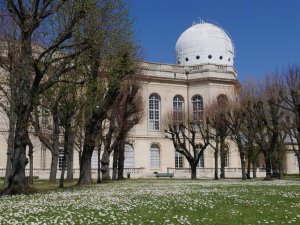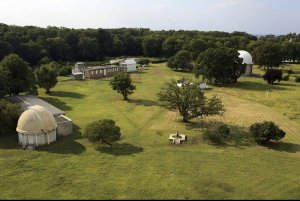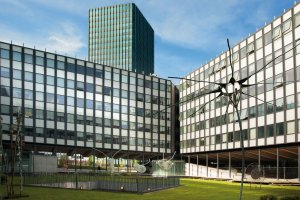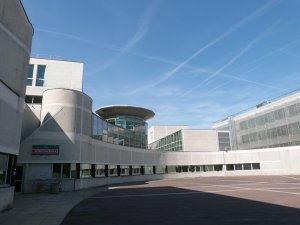The (hardware) instrumentation group
The (hardware) instrumentation group focuses on millimetre to THz heterodyne instruments for astronomy, planetary science and atmospheric remote sensing, though we are open to other applications. The instrumentation group (also called GEMO – group Groupe Expérimental Micro-Ondes) carries out lots of research and development work and produces state of the art components and instruments. The GEMO is well represented at international conferences and publishes in key journals. Its members organise conferences and are in many peer review committees. The laboratory is very well equipped and is physically located at the Paris observatory. The activities of the group can be divided in 3 sub-groups :
– Schottky technology
– Cryogenic mixers (SIS and HEB)
– Instrumentation
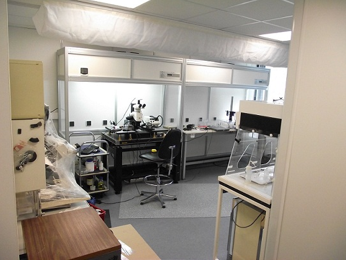
Laboratory for mounting diodes and small components.
Sup-group Schottky
Schottky technology at LERMA in partnership with Laboratoire de Photonique et Nanostructures - CNRS "
Among different technologies available to build THz and sub-THz heterodyne receivers for radio-astronomy and aeronomy, planar Schottky diode technology plays a crucial role. Actually, it is the technology of choice that enables the building of high efficiency frequency multipliers capable of reaching into the THz regions. It is therefore the technology most often used for building compact and robust local oscillators for heterodyne receivers for space observatories like Herschel, successfully launched on May 2009, by the European Space Agency. Schottky diode mixer technology is similarly important for long-term planetary and atmospheric space missions that cannot afford the mass, the power and ultimately the cost of cryocoolers or liquid helium cryostats as it is the sole technology available to build sub-millimeter-wave low-noise mixers working at room temperature.
LERMA has a strong and long established expertise in designing state-of-the-art THz frequency multipliers and Schottky mixers. Notably, it has designed or re-designed for the Jet Propulsion Laboratory (NASA-CALTECH) several THz frequency multipliers of HERSCHEL-HIFI (*) band 6 and band 7 local oscillators. It has also designed the first solid-state electronic source working at room temperature in the 2.5-2.7THz band for JPL.
Since 2012, LERMA has developed a Schottky process in partnership with LPN that enables the fabrication of sub-micron anode Schottky diode-based MMICs working at THz frequencies. This process is entirely based on electron beam lithography. LERMA-LPN devices are fabricated on thin GaAs membranes and feature beamleads for precise RF grounding of the diodes to the waveguide micro-mechanical structure. These beamleads are made with a front side process for better accuracy and flexibility. LEMRA-LPN Schottky process will be used to fabricate a sub-millimeter wave frequency multiplier for JUICE-SWI (**).
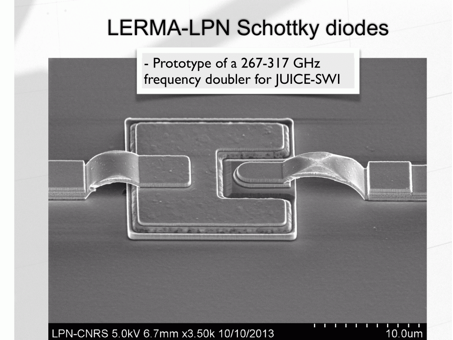
Prototype of the frequency doubler for JUICE-SWI.
LERMA has recently initiated a collaboration with the University of Salamanca - Dpto. Física Aplicada, Escuela Politécnica Superior de Zamora on the physical modelling of THz Schottky diodes using 2D DC and AC Monte Carlo simulations. This work is aimed at improving the design of THz Schottky circuits, in particular for JUICE-SWI.
(*) Herschel Heterodyne Instrument for the Far Infrared, launched by ESA in May 2009. HERSCHEL ended its operations in 2013.
(**) JUpiter ICy moons Explorer - Submillimer Wave Instrument will investigate the temperature structure, composition and dynamics of Jupiter’s stratosphere and troposphere, and the exospheres and surfaces of the icy moons. SWI is a heterodyne spectrometer using a 30 cm antenna and working in two spectral ranges 1080-1275 GHz and 530-601 GHz with spectral resolving power of 1E7.
Cryogenic mixers (SIS and HEB)
Superconducting Hot Elctron Bolometers (HEB) Mixers
Superconducting hot electron bolometers (HEB) have been proved to be devices of choice as mixer element for heterodyne receivers at THz frequency. We are in collaboration with LPN to develop NbN HEB mixers with integrated planar antenna on membrane or thick silicon substrate. Successful NbN HEB fabrication process has been developed with whole E-beam lithography and reduced number of steps than conventional ones. Fig. 1 illustrates an example of realized HEB devices. It consists of a 2 µm wide, 0.2 µm long and 3 nm thick NbN bridge. One of the HEB mixers with integrated lens/antenna configuration has demonstrated the state-of –the-art noise temperature of 800 K at 2.5 THz during a measurement camping in the frame of a European research program.
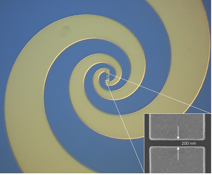
Fig. 1 SEM micrograph of the quasi-optical NbN HEB mixer. The NbN bridge is connected to the spiral antenna made of Au. The inset is a close-up of the NbN bridge of 2 µm wide and 0.2 µm long.
We also carried out studies on a novel concept of HEB mixer using devices on membrane substrates with the objective to offer an alternate solution to devices on bulk substrates to achieve a better beam convergence and lower losses and also to get an easier integration for future development for much higher frequencies. The fabrication process is partly performed at the LPN and then completed at the LERMA. The concept consists of processing a phonon-cooled NbN HEB and a planar antenna on a 1.4 µm thick SiO2/Si3N4 membrane and using a focusing mirror to couple the input signal to the HEB. Heterodyne measurements at 600 GHz with a mixer of the new concept have been performed with success.
We are also actively working on the coupling of the radiation produced by THz Quantum Cascade Lasers to HEB mixers. We are collaborating with IEF for experiments using QCL as local oscillators at frequencies above 2 THz.
Superconductor-Isolator-Superconductor (SIS) Junctions
1. SIS mixers for Herschel-HIFI band 1
Our lab has been responsible of the development and realization of Herschel-HIFI band 1 mixers covering the frequency range from 480 to 640 GHz, in collaboration with IRAM which was in charge of the SIS junction process. Several innovative concepts have been adopted during the mixer’s design and fabrication. The delivered band 1 mixers are the only ones among all HIFI mixers with the sensitivity better than ESA’s specifications. The noise temperature over the whole band 1 frequency range and the required specification are shown in Fig.2. During more than 3 years (2009-2013) observation in orbit, the band 1 mixers remained the most sensitive and have achieved the highest number of observation requests.
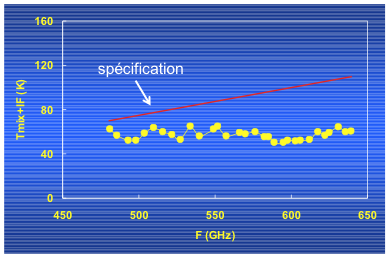
Fig. 2 Noise temperature of the delivered SIS mixer over the whole HIFI band 1 frequency range
2. Research and development on SIS junctions
With the facilities of the clean room of "Pôle instrumental", we successfully developed niobium SIS junction fabrication process. We now plan to develop with the new sputtering machine NbN and NbTiN SIS junctions in order to increase the working frequency. The current research work concerns mainly the study of the THz emission of parallel small junction array with the aim of building integrated SIS receivers.
Instrumentation
The instrumentation group provides components for and builds scientific instruments. On the one hand the GEMO builds some of its own test equipment to allow the characterization of the components developed. The group has built several Fourier transform spectrometers, a beam measurement stand, an intermediate frequency test bench and has cryogenic measurement stands. On the other hand, the group is involved in scientific instruments either as P.I. or as a major partner. Recently the LERMA instrumentation group delivered the band 1 SIS mixer for the HIFI instrument on the Herschel satellite, and has contributed to the MIRO instrument on ROSETTA besides others. It is now responsible for the W-band synthesiser of the Submillmeter Wave Instrument on the JUICE satellite. LERMA has obtained a grant (Imolabs) together with astronomers and chemists part of which allows to develop new instrumentation for (sub)mm to THz molecular spectroscopy to measure molecules, ions and radicals that are interesting for astrochemistry. The LERMA group is well represented in the proposals for many future missions, such as the Millimetron satellite, the FIRI satellite, the CII mapper and the THEO satellite.

Fourier transform spectrometer
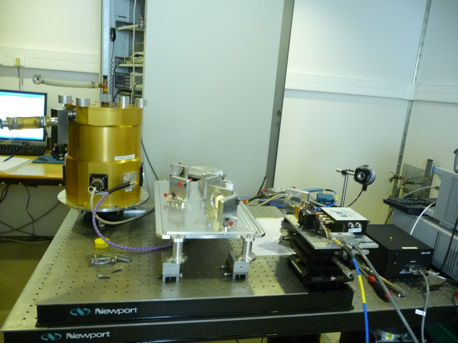
Test bench in the Faraday Cage.
links:
HIFI – http://herschel.jpl.nasa.gov/hifiInstrument.shtml
Herschel - http://www.esa.int/Our_Activities/Space_Science/Herschel/
MIRO - http://sci.esa.int/rosetta/35061-instruments/?fbodylongid=1641
ROSETTQ - http://sci.esa.int/rosetta/
JUICE - http://sci.esa.int/juice/
Millimetron - http://asc-lebedev.ru/index2.php?engdep=20
Imolabs - http://astro.ens.fr/index.cgi?exe=1389742

